Karma Barnes, an interdisciplinary artist from Tāmaki Makaurau, Aotearoa-New Zealand, attended the Unidee Art Residency at Cittadellarte in late November – early December to carry out a research project at Cittadellarte, as an ambassador for The Third Paradise project. While there, she created two new works, “Tutto è Fatto di Tutto il Resto (Everything is Made of Everything Else) and Filo di Terra e Speranza (Thread of Earth and Hope).
Barnes has been working for over twenty years to redefine intersections of art, land, and community. Currently based on Bundjalung Country in Australia’s Northern Rivers region, she is known for her site-responsive installations and socially engaged, participatory practices. Her new body of work is informed by her lived experience and applied knowledge derived from responding to climate-induced disasters on the east coast of Australia. She develops frameworks for future generations through creative recovery and community-engaged art practices, thereby generating resourcefulness and hope in the face of adversity. The materiality and formal qualities of her sculptural artworks connect viewers with an intuitive and conceptual understanding of ethical commitment of care underlying her aesthetics.
Indeed, Barnes’ practice is deeply immersed in an aesthetics of care. That is to say, care for the communities with whom she interacts, care for the environment both natural and manmade in which her relational actions and material installations take place, and care for the future of the Earth and all its inhabitants – humans and nonhumans alike.
In November of this year, Barnes travelled to Venice as a finalist in the 2024 Arte Laguna Prize Exhibition. She exhibited her monumental sculptural installation Co lapses (2024) – a poetic family of suspended biomorphic pods representing both human and nonhuman bodies, entanglements, and interdependencies, and the shared passage of time, chance, and change. This year’s Prize (the 18th and 19th editions) showcased her work alongside that of well over two hundred international artists. Within the dramatically soaring architecture of the venerable Arsenale Nord, these artists’ paintings and sculptures in diverse media represented contemporary, emerging art from around the globe.
Barnes’ work questions and opposes how Western civilization has constructed an entirely artificial world, setting off irreversible environmental degradation and over consumption in every facet of the everyday. As caretakers, humans’ role is to safeguard the planet. The concept of Pistoletto’s Third Paradise represents a new phase including all of humanity, creating a harmonious balance between the artificial and the natural, requiring a fundamental rethinking of the ethical principles and values guiding collective existence. The Third Paradise serves as a powerful metaphor, inspiring individuals to take personal responsibility in shaping a shared global vision of care. As Barnes has stated, “During my residency, the opportunity to live and work within Cittadellarte – a manifestation of The Third Paradise and its principles – allowed for deep reflection and development of my conceptual practice. Experiencing Michelangelo Pistoletto’s works in person provided a unique lens through which to consider how the principles of The Third Paradise can create a meeting ground – a place for dialogue and connection.”
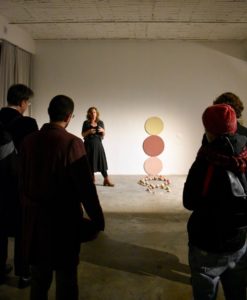
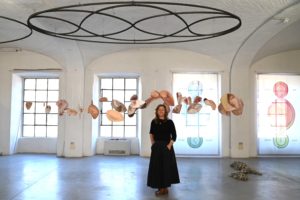
Co-Lapses (2024) at Arte Laguna
In Venice, Barnes debuted a monumental iteration of Co-Lapses, originally exhibited on a smaller scale in Australia. The site specific installation connects the soaring ceilings of the Arsenale Nord to its stone floors. Ten elegantly suspended, organically-shaped pods fabricated in 3D printing, resulting from Barnes’ use of imaging technology, echo earthen sculptural practices. Local industrial pigments used for Venice’s buildings emerge downward from nipple-like openings, and stream to the floor. A slowly forming landscape builds into ten peaked, miniature mountains, referencing ancient relationships between bodies and the land, creating a durational piece whose underlying terrain physically mutates throughout the exhibition. The installation as a whole calls to mind the passage of deep time, as well as Earth’s biological and social systems.
Originally, Barnes’ motivation for the work emerged from observing mud wasps building their nests in her studio: the tiny earthen capsules they constructed on walls and ceiling were multi-coloured red and yellow ochred, due to the insects’ taking pigments from her collection. As such, Co-Lapses is a poetic translation of the wasps’ design strategies for protecting the eggs they lay. Here, in keeping with Pistoletto’s aims to harness interdisciplinary research to usher in The Third Paradise, Barnes’ interest in biomimicry – the practice of translating nature’s strategies into the world of human designs for problem solving, and the creative application of natural systems and processes toward human solutions – comes into play. Thus, Co-Lapses eloquently reminds us that the interconnectedness of our planet’s inhabitants extends beyond human perception and boundaries, and that our world is co-created, through human-nonhuman and other-than-human relationships.
Fondazione Pistoletto – Cittadellarte Residency Highlights: Art, Research, and Collaboration
For Barnes, the “ethical and aesthetic implications of relationality between humans and the world” are based upon relations of equality, “rather than exploitation or contractual obligation.”¹ A sense of equality plays out in her work, whether it be sculpture or painting, as can be seen in the two installations she created at her residency at Cittadellarte, namely, Tutto è Fatto di Tutto il Resto (Everything is Made of Everything Else) and Filo di Terra e Speranza (Thread of Earth and Hope). In both she incorporates localized clay and industrial pigments, such as pompeian pink, terra rosa, sienna, and yellow ochre to explore the interconnectedness of all things whether they be of humble or more illustrious origins. Tutto è Fatto di Tutto il Resto (Everything is Made of Everything Else) was then presented at Unidee Open Studio.
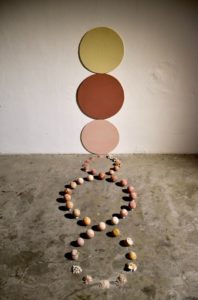
With Tutto è Fatto di Tutto il Resto, she makes perfect textured circles from clay and pigment, placing them vertically on the wall in a form echoing The Third Paradise symbol of rebirth. Where the bottom circle meets the floor, she places small spheres crafted in the simple Japanese art of dodorango (mud ball) on the floor in a linear outline of the shape of Pistoletto’s symbol of rebirth. Thus, three flat, vertical circles meet a tripartite infinity symbol resting on the floor. Notably, of these twenty to thirty mud and pigment balls (which on a micro scale resemble planets, such as Mercury, Mars, or Jupiter), approximately ten are in various stages of disintegration. For Barnes, the humble yet beautiful and elegantly crafted installation, “reflects the cyclical nature of creation, destruction, and renewal.” In Tutto è
Fatto di Tutto il Resto, Barnes has taken the three-part infinity symbol of Pistoletto’s rebirth theme of The Third Paradise and transformed it into a meditation on equality, balance, wholeness, infinity, and decay. Of his theorem of “trinamics”, Pistoletto has stated it to be, “the dynamics of the number three. It is the combination of two units that gives rise to a third distinct and new unit.”²
For Barnes, this installation fosters dialogue about resilience, hope, self-responsibility, and interdependence in the face of climate change. Barnes explains, “By exploring the psychological and internal transformation as reflective of external environmental shifts and changes, with one side of the triple infinity Third Paradise symbol representing the creation process and the opposite side showing the destructive process. The middle of the symbol has a coming together of wholeness.
Subsequently, the three circular forms creating the triple infinity on the wall all present as forms of wholeness and manifestation of The Third Paradise. The work reflects geological shifts over long durations and psychological shifts and emergent states of being as a way of finding hope through the comprehension of impermanence and reflection on the context of time and change.”
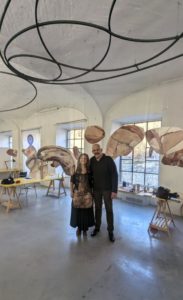
Karma Barnes and Francesco Saverio Teruzzi.
Filo di Terra e Speranza (Thread of Earth and Hope), a collaborative piece created with Francesco Saverio Teruzzi, Cultural Project Manager for Artivator, incorporates thirty-two small-scale paintings inspired by Barnes’ conversations with the nearby Cervo river, snow, and earth. The organically-shaped paintings incorporate an Italian pigment palette of industrial colors and graphite. The paintings are hung by invisible filaments from Pistoletto’s three metre-long cast iron Third Paradise symbols (also suspended, but from the ceiling) substantiating humanity’s interconnectedness with the environment in a visual language of abstract marks, gestures, color, and texture. The paintings, floating weightlessly at a height of about two metres, can be seen as forms Barnes observed in drawing observations, such as remnants of geological cycles left in the earth, and imprints left behind by water and its active motion, as well as stone and rock shards formed by weathering and erosion – all fragments of a larger dialogue left in the landscape.
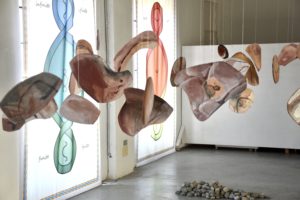
Their shapes reiterate the negative spaces of Pistoletto’s airborne, elliptical sculpture; their liveliness contrasts with the solidity of their surrounds, that is, the white, bricked arches of Cittadellarte’s nineteenth century industrial space’s vaulted ceiling. For viewers, the activity of moving around underneath the hanging paintings, experiencing them up close individually, or at a distance as a lyrical, and changing whole, offers them an active role within the conversation.
Barnes explains, “My work embodies the quiet strength of resilience and optimism,” referencing the idea of glimmers – small moments of light and hope guiding us through challenging times. Her installations transform these fleeting, positive experiences into powerful symbols of collective healing and ecological care. Looking forward, Barnes will continue to bridge the realms of research, installation, and social practice. Her art will serve as a call to action. By embedding the principles of The Third Paradise into her work, she will seek to inspire communities to embrace compassion, self-responsibility, and interconnectedness.

